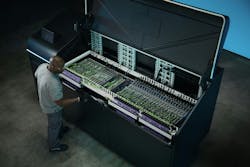The Rebound Effect in the Data Center Industry: How to Break the Cycle
In today’s day and age, it’s (almost) impossible to be blissfully unaware of the consequences our consumption is having on the planet and the consequent urgency with which we need to address reducing environmental footprints. The datacenter industry, long under scrutiny for its environmental impact, is making progress in this regard with a range of efforts spanning efficient cooling technologies and heat reuse solutions. However, the increasing demand for data often outweighs efficiency gains in a phenomenon known as the rebound effect.
The Industry’s Efforts to Reduce Environmental Footprints
The data center industry is making a lot of progress in finding ways to reduce its environmental impact, adapting to future regulations and to climate risks. Different solutions are being implemented and investigated:
- Finding energy efficient technologies and cooling systems
- Purchasing carbon-free energy
- Looking at reducing water consumption
- Extending the lifespan of the IT
- Sourcing sustainable and circular materials for construction and operation
- Exploring heat reuse solutions
- Implementing modular design that allow for scalable growth and resource efficiency
- Monitoring and reporting energy usage, emissions and water consumption to enable data-driven decisions for further improvement
Prevalent Sustainability Challenges
Most solutions seem to focus on further innovation. Innovation is often seen as advancement, a “do no harm” way to solve environmental problems, with the idea that we will save the world as long as we discover the next best thing that will make us more efficient.
Yet, as we have witnessed, - especially this year - the impact of datacenters is significantly increasing with the rise of AI and IoT, and this trend will persist as more and more countries and individuals gain internet access.
While data centers strive for efficiency, these gains may not reduce their environmental footprint; instead, they often lead to increased data production. This phenomenon, known as the rebound effect, can result in greater resource consumption and environmental strain.
To address projected growth without harming the environment or contributing to climate change, we must recognize that sustainable innovation alone is insufficient; tackling the rebound effect is essential for achieving true sustainability.
How Do We Address the Rebound Effect?
I do not pretend to have the all-in-one solution for this complex and multifaceted challenge. However, I do believe that part of the solution encompasses the following:
- Raising awareness is the first step. The more conscious people are about the problem, the more likely they are to find the right solutions. One efficient way of achieving this is running collaborative workshops, like the Digital Collage, involving employees and key stakeholders to help them gain a holistic understanding of the problem. Many other formats and media exist to achieve this objective.
- Another step in the right direction includes rethinking how we consume data, prioritizing data relevance and therefore tackling the problem from its root. In a world with limited resources, unlimited growth isn’t compatible. Data centers, and the entire industry, have a key role to play in accompanying customers and/or users on how to reduce data consumption. Also, although it might seem counterproductive for data centers to promote less data usage, as it could lead to less revenue, it could also be a different way to generate value through consultancy and other solutions.
- The data center industry has many collaborative platforms to seek common sustainable practices, innovations and measurements. Transparency and collaboration are also needed when it comes to finding solutions to remediate the rebound effect.
- Ultimately, change across the industry and users' goodwill will not succeed in tackling the rebound effect without regulatory measures. Establishing regulations that limit data growth and mandate sustainability practices are critical for controlling the overall environmental impact of the industry.
There are more solutions to address the rebound effect, including some that remain undiscovered because those who hold the answers may not yet recognize the problem. This reinforces my belief that raising awareness is essential and should be a fundamental part of any sustainability strategy.
Does This Mean That Efforts to Enhance Efficiency Are Pointless?
Not at all. Each initiative to reduce the industry’s impact is necessary and complementary to tackling the rebound effect.
Taking Responsibility - And Action!
I myself work for an impact company which technology reduces massively data center’s energy and water consumption, as well as offering many other sustainable advantages. As impactful as I find this to be, I do also believe that we have a responsibility to raise awareness by collaborating with our employees, customers, and partners to help the industry rethink its business practices and build a sustainable future.
About the Author

Nathalie Cruchet
Head of Sustainability & ESG at Submer, Nathalie Cruchet makes the most of her 20 years of experience in the IT industry and her passion for the environment to actively contribute to a more sustainable world. Connect with Nathalie on LinkedIn.
With hundreds of megawatts deployed in production, Submer is on a mission to optimize datacenter operations and lead the way to a greener future. Click here to learn more about Submer’s single-phase immersion cooling technology.




